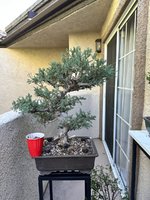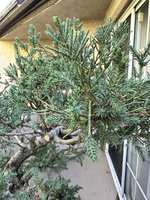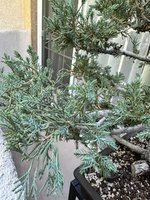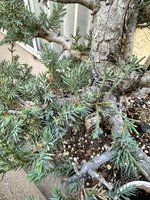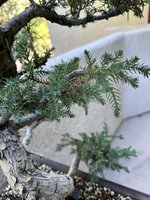Hello everyone, I’m new here and just purchased my first juniper pre bonsai. I live in California USDA Hardiness Zone 9 and Zone 10. I need help to ID the tree and also see if my tree is healthy. It seems like the color is kinda dull. I tried white paper method to see if there are any critters but couldn’t see anything. Online pictures show bright green junipers but mine is not as colorful. Maybe I’m just freaking out hahaha. Thanks in advance.
You are using an out of date browser. It may not display this or other websites correctly.
You should upgrade or use an alternative browser.
You should upgrade or use an alternative browser.
Need help with ID and health.
- Thread starter arodden11
- Start date
bdmatt
Mame
Hi, welcome to the forums!
Very nice material. My first guess is prostrata juniper. Some prostrata have a deep green/blue tint to them. Though they can also be a lighter green. Here's an example of my prostrata. I also have pictures of when it was juvenile, but I'd need to dig for those.

The tree looks fine. It looks to be recovering from some sort of trauma if it's pushing out new growth like that. I'm thinking it was pruned back heavily sometime this year, closer to summer. Prostrata tend to revert back to juvenile foliage after some heavy pruning or drastic root work. Did the seller mention what species it was or what he done to it?
Very nice material. My first guess is prostrata juniper. Some prostrata have a deep green/blue tint to them. Though they can also be a lighter green. Here's an example of my prostrata. I also have pictures of when it was juvenile, but I'd need to dig for those.

The tree looks fine. It looks to be recovering from some sort of trauma if it's pushing out new growth like that. I'm thinking it was pruned back heavily sometime this year, closer to summer. Prostrata tend to revert back to juvenile foliage after some heavy pruning or drastic root work. Did the seller mention what species it was or what he done to it?
Shibui
Imperial Masterpiece
Juniper colour can vary through the year. Spring growth is usually greener but it can be more dull as the year progresses.
Colour also varies from species to species and even cultivars within a species. We have selected many different colored types for landscaping so comparing one juniper colour with a different type cannot be useful.
Growth appears to be healthy in the photos so I would not be panicking just yet.
I'm not familiar with the species or variety but accurate ID is not really necessary because all junipers have similar needs and requirements for care.
Knowing what it is may help when comparing colour and health but may be difficult to get an accurate ID just from photos as there are so many species and cultivars and many look superficially similar.
Colour also varies from species to species and even cultivars within a species. We have selected many different colored types for landscaping so comparing one juniper colour with a different type cannot be useful.
Growth appears to be healthy in the photos so I would not be panicking just yet.
I'm not familiar with the species or variety but accurate ID is not really necessary because all junipers have similar needs and requirements for care.
Knowing what it is may help when comparing colour and health but may be difficult to get an accurate ID just from photos as there are so many species and cultivars and many look superficially similar.
Thank you Shibui.Juniper colour can vary through the year. Spring growth is usually greener but it can be more dull as the year progresses.
Colour also varies from species to species and even cultivars within a species. We have selected many different colored types for landscaping so comparing one juniper colour with a different type cannot be useful.
Growth appears to be healthy in the photos so I would not be panicking just yet.
I'm not familiar with the species or variety but accurate ID is not really necessary because all junipers have similar needs and requirements for care.
Knowing what it is may help when comparing colour and health but may be difficult to get an accurate ID just from photos as there are so many species and cultivars and many look superficially similar.
Bonsai Nut
Nuttier than your average Nut
Welcome to the site!
I am going to narrowly disagree with @bdmatt because I believe what you have there is a San Jose juniper. What's the difference? Not much. Both are Juniperus chinensus, so their care is very similar. One is Juniperus chinensus prostrata. The other cultivar is Juniperus chinensus "San Jose". However there are several things that lead me to believe the San Jose ID. First, "prostrata" by its very definition, means "prostrate". It is a mounding/weeping juniper cultivar. Yes, you can stake it upright and get it to grow in an upright form, but it will always have that mounding/weeping growth. Second, San Jose is notorious for its blend of immature needle foliage, and lanky adult scale foliage. I have personally never seen a San Jose that is 100% scale foliage, despite all attempts to convert all that prickly needle growth to smooth scale growth. And that steel blue/green foliage is very San Jose. (Your tree looks fine and healthy/ BTW) Finally - I'm assuming you live in SoCal, and that is ground zero for San Jose pre-bonsai. San Jose is a very strong cultivar, develops a thick trunk quickly, and is often found in landscape there. The only downside is that needle foliage. Because it grows much faster than a shimpaku Juniper, quite a few excellent juniper bonsai in SoCal are San Jose trees with shimpaku foliage grafts... so that over time all San Jose foliage has been replaced with soft shimpaku foliage.
If you had shown me your tree and said "I bought this tree locally - where do I live?" I would have said - SoCal. And if I had to guess... House of Bonsai or San Gabriel Nursery. That tree has San Gabriel Nursery written all over it
I am going to narrowly disagree with @bdmatt because I believe what you have there is a San Jose juniper. What's the difference? Not much. Both are Juniperus chinensus, so their care is very similar. One is Juniperus chinensus prostrata. The other cultivar is Juniperus chinensus "San Jose". However there are several things that lead me to believe the San Jose ID. First, "prostrata" by its very definition, means "prostrate". It is a mounding/weeping juniper cultivar. Yes, you can stake it upright and get it to grow in an upright form, but it will always have that mounding/weeping growth. Second, San Jose is notorious for its blend of immature needle foliage, and lanky adult scale foliage. I have personally never seen a San Jose that is 100% scale foliage, despite all attempts to convert all that prickly needle growth to smooth scale growth. And that steel blue/green foliage is very San Jose. (Your tree looks fine and healthy/ BTW) Finally - I'm assuming you live in SoCal, and that is ground zero for San Jose pre-bonsai. San Jose is a very strong cultivar, develops a thick trunk quickly, and is often found in landscape there. The only downside is that needle foliage. Because it grows much faster than a shimpaku Juniper, quite a few excellent juniper bonsai in SoCal are San Jose trees with shimpaku foliage grafts... so that over time all San Jose foliage has been replaced with soft shimpaku foliage.
If you had shown me your tree and said "I bought this tree locally - where do I live?" I would have said - SoCal. And if I had to guess... House of Bonsai or San Gabriel Nursery. That tree has San Gabriel Nursery written all over it
Thank you for the reply Bonsai Nut. It’s a good info regarding the tree type because it looks like San Jose Juniper and Prostrata get mixed alot. Oh and I bought the tree from the place called Kimura Bonsai & Landscape Nursery in Castaic CA. Really nice people that have time to help and answer questions. Bought it from here because few other places that I visited in Los Angeles they wouldn’t even want to talk to me. Also the prices here were way better.Welcome to the site!
I am going to narrowly disagree with @bdmatt because I believe what you have there is a San Jose juniper. What's the difference? Not much. Both are Juniperus chinensus, so their care is very similar. One is Juniperus chinensus prostrata. The other cultivar is Juniperus chinensus "San Jose". However there are several things that lead me to believe the San Jose ID. First, "prostrata" by its very definition, means "prostrate". It is a mounding/weeping juniper cultivar. Yes, you can stake it upright and get it to grow in an upright form, but it will always have that mounding/weeping growth. Second, San Jose is notorious for its blend of immature needle foliage, and lanky adult scale foliage. I have personally never seen a San Jose that is 100% scale foliage, despite all attempts to convert all that prickly needle growth to smooth scale growth. And that steel blue/green foliage is very San Jose. (Your tree looks fine and healthy/ BTW) Finally - I'm assuming you live in SoCal, and that is ground zero for San Jose pre-bonsai. San Jose is a very strong cultivar, develops a thick trunk quickly, and is often found in landscape there. The only downside is that needle foliage. Because it grows much faster than a shimpaku Juniper, quite a few excellent juniper bonsai in SoCal are San Jose trees with shimpaku foliage grafts... so that over time all San Jose foliage has been replaced with soft shimpaku foliage.
If you had shown me your tree and said "I bought this tree locally - where do I live?" I would have said - SoCal. And if I had to guess... House of Bonsai or San Gabriel Nursery. That tree has San Gabriel Nursery written all over it
Bonsai Nut
Nuttier than your average Nut
Kimura is a great nursery. It is owned by Bob Pressler who is a member here (@bonsaibp) . If you go to his site and scroll to the bottom of the front page, you will see a scrunchy San Jose juniper... with 100% needle foliage.
Wow awesome. Thank you so much Bonsai Nut I’m starting classes with him next week too.Kimura is a great nursery. It is owned by Bob Pressler who is a member here (@bonsaibp) . If you go to his site and scroll to the bottom of the front page, you will see a scrunchy San Jose juniper... with 100% needle foliage.
Bonsai Nut
Nuttier than your average Nut
Tomorrow once the sun comes out, I'll take some photos of San Jose versus prostrata foliage (at least on some of my trees) and I think you will see a difference.Wow awesome. Thank you so much Bonsai Nut I’m starting classes with him next week too.
Sounds good @Bonsai Nut. Thank you again.Tomorrow once the sun comes out, I'll take some photos of San Jose versus prostrata foliage (at least on some of my trees) and I think you will see a difference.
Similar threads
- Replies
- 10
- Views
- 278
- Replies
- 3
- Views
- 257

